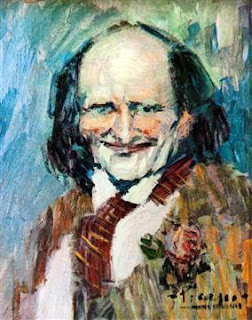Whenever I am faced with writing critically about Picasso I am presented with a problem. I think he is a genius! This may not seem to be a problem to others but I certainly feel it clouds my ability to be critical. Instead I feel like glorifying him as the unbelievable artist he was; a visionary, a painter and an artist that was always prepared to defy conventions and explode the artistic and cultural genres of the moment as well as creating unbelievable masterpieces.
The Courtauld Gallery presents us with a relatively small collection of some of Picasso’s most daring, beautiful, evocative and soulful paintings. As you enter the first room you are at once confronted with the real colour that is so distinctive of Picasso’s work. Rich reds, blues ,greens and browns accost us. The works on display figure from the early 1900’s and in fact 1901 was a breakthrough year for Picasso as we see him launching his career in Paris with his first major exhibition at the gallery of art dealer Ambroise Vollard. We learn that Picasso worked furiously for several weeks, often producing three paintings in one day.
 His rather unusual portrait of ‘Bibi la Puree’ – a grotesque, ugly absinthe drinker and bohemian who used to inhabit the bars and salons of the demi monde in Paris is outstanding. The art critic Jonathan Jones aptly points out Picasso’s originality in his choice of portrait and his appetite for ugliness. Jones demonstrates Picasso’s fascination with the low life and demi monde and his fondness for the other famous artist of Parisian night life, Toulouse Lautrec. His portrait shows no mercy as he paints his leering grin, dandyish bold clothes; you can almost smell the wine that is coming from his bad breath. Similarly Picasso’s portrait of the dwarf dancer , ‘La Nana’ also highlights this fascination for nightlife and the low life that inhabited the streets and dance halls of Montmartre.
His rather unusual portrait of ‘Bibi la Puree’ – a grotesque, ugly absinthe drinker and bohemian who used to inhabit the bars and salons of the demi monde in Paris is outstanding. The art critic Jonathan Jones aptly points out Picasso’s originality in his choice of portrait and his appetite for ugliness. Jones demonstrates Picasso’s fascination with the low life and demi monde and his fondness for the other famous artist of Parisian night life, Toulouse Lautrec. His portrait shows no mercy as he paints his leering grin, dandyish bold clothes; you can almost smell the wine that is coming from his bad breath. Similarly Picasso’s portrait of the dwarf dancer , ‘La Nana’ also highlights this fascination for nightlife and the low life that inhabited the streets and dance halls of Montmartre.
In the second room of the exhibition we are presented with paintings that collectively formed part of Picasso’ s Blue Period’ in its early stages. Painted during the years 1901-1904 this was a time when Picasso painted essentially monochromic paintings in differing shades of blue and blue green and often chose doleful subject matter and austerity. The paintings in the room are more melancholic and sombre in tone and pitch. Many of his subjects are sorrowful figures living on the fringes of society or outcasts. His painting, ‘Harlequin and companion’ is subdued and unusual. The orange of the girl and the blues of the harlequin seem to clash together to create a subdued and sad atmosphere. In many ways Picasso is reinventing café society painting by focusing on members of society that were margionalised. Another sorrowful painting is his ‘Casagemas in his coffin’ – a close up of his friend’s head, painted in an eerie, intense blue, who sadly committed suicide in a Montmartre café. The mood is deeply sombre and introspective hinting of melancholic and great sorrow. It was his death that apparently inspired the beginning of the Blue Period as Picasso was known to have said, “I started painting in blue when I learned of Casagema’s death’.
In contrast to these paintings is one of the highlights of the whole exhibition – it is his beautiful and evocative ‘Child with a dove’. Here we see a child holding a dove close to her chest and standing in front of a subdued blue background and next to a multi colored ball. It is a soft, peaceful painting that both celebrates the serenity and the fragility of childhood. The little girl is protected and closeted and there is little of the sombre mood that embue the other paintings indicating that it was painted just before the beginning of the Blue Period.
Go and see this magnificent exhibition while it lasts, there are many masterpieces to admire and a chance to lose yourself in the colours and brilliance that is Picasso.
By Larissa Woolf, Arts Editor, VisitMuseums.com

